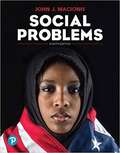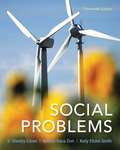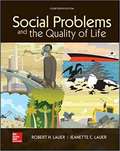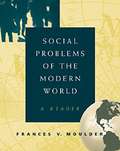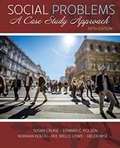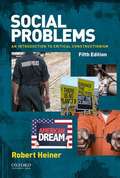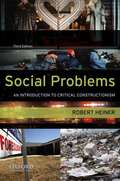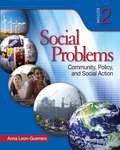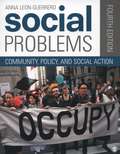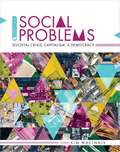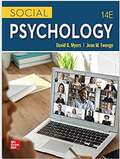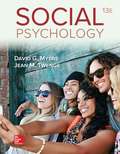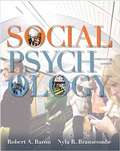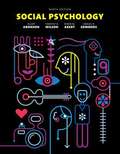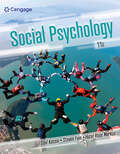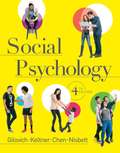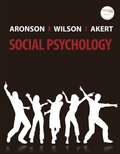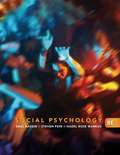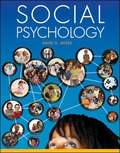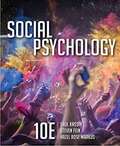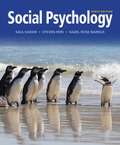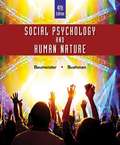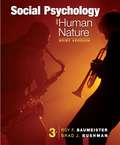- Table View
- List View
Social Problems
by John J. MacionisMacionis's book is the only social problems text that explains how society frames social problems and solutions through politics. The text analyzes social issues and policies, using the concepts of sociological theory and the everyday language of politics. It also helps students understand the attitudes and values that define the political spectrum in the United States. Once students know how social problems are defined by our society through politics, and how the policies to solve these problems are developed, they can become involved in solving social problems through activism and political involvement.
Social Problems
by Steven E. BarkanSocial Problems: Continuity and Change by Steve Barkan is a realistic but motivating look at the many issues that are facing our society today. As this book's subtitle, Continuity and Change, implies, social problems are persistent, but they have also improved in the past and can be improved in the present and future, provided that our nation has the wisdom and will to address them. It is easy for students to read a social problems textbook and come away feeling frustrated by the enormity of the many social problems facing us today. Social Problems: Continuity and Change certainly does not minimize the persistence of social problems, but neither does it overlook the possibilities for change offered by social research and by the activities of everyday citizens working to make a difference. Readers of Steve Barkan's book will find many examples of how social problems have been improved and of strategies that hold great potential for solving them today and in the future.
Social Problems (Thirteenth Edition)
by D. Stanley Eitzen Kelly Eitzen Smith Maxine Baca ZinnTaking a conflict approach, Social Problems, 13e examines social problems, how they are interrelated to other problems, and society's role in their creation and perpetuation. This text addresses interesting subjects, such as corporate crime, urban decay, poverty and the changing economy. The thirteenth edition focuses more deliberately on five major themes: the structural sources of social problems; the role of the United States in global social problems; the centrality of class, race, gender, sexuality, and disability as sources of division, inequality, and injustice; the critical examination of society; and solutions to social problems. MySocLab is an integral part of the Eitzan / Zinn / Smith program. Key learning applications include MySocLab Videos, Social Explorer and Sociology in Focus Blog. Teaching & Learning Experience Personalize Learning - MySocLab is an online homework, tutorial, and assessment program. It helps students prepare for class and instructor gauge individual and class performance. Improve Critical Thinking - Chapter organization follows a logical framework that traces a problem from its origin to solution. Engage Students - International, national, and personal examples help students understand issues better. Explore Theory - Major sociological theories within context of social problem are discussed. Understand Diversity - Features help students think globally about defining a solution to social problems. Support Instructors - A number of Instructor Resources including PowerPoint Presentations, MyTest Test Bank, and Instructor's Manual.0205949185 / 9780205949182 Social Problems Plus NEW MySocLab with eText -- Access Card Package Package consists of: 0205206530 / 9780205206537 NEW MySocLab with Pearson eText -- Valuepack Access Card 1-095 Pub 0205881882 / 9780205881888 Social Problems
Social Problems And The Quality Of Life
by Robert H. LauerSocial Problems and the Quality of Life is a thought-provoking text providing thorough coverage of the social problems that most acutely impact the quality of our lives. Chapters define what a social problem is, and address a number of questions crucial to understanding social problems. Learning is supported through several pedagogical features such as Global Comparison boxes and public policy sections, as well as study questions, internet resources, and ample review materials. These sources all combine to paint a complete picture of how to understand the unique social problems of today’s world.
Social Problems of the Modern World: A Reader
by Frances MoulderProvides Sociology instructors with a variety of readings in all of the areas covered in a typical Social Problems course. The reader uses a global perspective, in order to help students understand that the social problems faced by people in the U.S. and around the world are increasingly shaped by our common fate in this interconnected world. At the same time, at least half of the articles in each chapter focus on the U.S., in order to engage students with issues that are immediate and relevant to their own personal lives and the communities in which they live.
Social Problems: A Case Study Approach
by Norman Dolch Helen Wise Edward Polson Neller Ree Wells-Lewis Susan CruiseSocial Problems: A Case Study Approach Fifth Edition by Norman Dolch, Helen Wise, Edward Polson, Neller Ree Wells-Lewis, and Susan Cruise.
Social Problems: An Introduction To Critical Constructionism
by Robert HeinerSocial Problems: An Introduction to Critical Constructionism, Fifth Edition, synthesizes conflict theory and social constructionism to help students think critically about social problems. A concise, student-friendly alternative to all-encompassing standard textbooks, this book examines a single theoretical paradigm in depth, demonstrating how theory can be used to understand a range of critical social issues.
Social Problems: An Introduction to Critical Constructionism (3rd Edition)
by Robert HeinerNow in a new edition, Social Problems: An Introduction to Critical Constructionism synthesizes conflict theory and social constructionism to help students think critically about social problems. A concise, student-friendly alternative to all-encompassing standard textbooks, this book examines a single theoretical paradigm in depth, demonstrating how theory can be used to understand a breadth of real world structures. Robert Heiner focuses on the four problems most often encountered in social problems courses: inequality, family, crime and deviance, and overpopulation and the environment. Heiner's critical approach helps students conceive of societal problems as socially constructed phenomena whose importance varies according to media attention and the agendas of particular interest groups. Furthermore, his critical point of view leads students to reevaluate their own preconceived notions and beliefs, in turn generating lively classroom discussions. Revised and updated in this third edition, Social Problems now includes a glossary of key terms and reinforcing end-of-chapter questions, as well as new discussions of such issues as immigration. Additional graphics help visually illustrate key concepts and ideas. Social Problems: An Introduction to Critical Constructionism, Third Edition, is ideal for social problems courses. Given its readability and consistent application of theory, this book could also be used in introductory sociology courses and social theory courses.
Social Problems: Community, Policy, and Social Action (2nd edition)
by Anna Leon-GuerreroThe text focuses on inequalities, examining how race and ethnicity, gender, social class, sexual orientation, and age determine our life chances. Each chapter includes a discussion of relevant social policies or programs and highlights how individuals or groups have made a difference in their communities.
Social Problems: Community, Policy, and Social Action Fourth Edition
by Anna Y. Leon-GuerreroThe approach offered by this book is threefold: 1. ) to humanize the social problems with voices of experience, i.e. the poverty stricken, to the voices of change, i.e. the social workers, policy makers, student community volunteers; 2. ) each chapter will address the consequences and responses to a social problem; 3. ) to provide an effective platform for discussion thru the use of boxed features, learning checks integrated into chapter presentations, discussion questions, and the use of a limited virtual classroom on a companion website. The hallmarks of the book will be its integrated theme of race, class, and gender; emphasis on 'service learning' (which focuses on student awareness of effective community responses to social problems); critical thinking and active learning thru the text presentation and pedagogy to go beyond the often disheartening parade of social problems; and the use of the internet and unique print supplements to expand on what is intended to be a briefer book than most. The book is intended to have a strong U. S. focus with a global perspective interwoven where appropriate. Social Problems offers the following unique features and benefits: Voices in the Community a section in each chapter offering testimony from those experiencing or doing something about social problems Visual Essays in each section to highlight a particular social problem or solution in the context of actual family and individual experiences. Chapters will have photos interspersed. Internet and community exercises at the end of each chapter to present the opportunity for further research and to give students a chance to explore chapter concepts in a direct way in the community What Does it Mean to Me? A feature intended to bring the analysis of the problem being studied down to the level of the individual. Inclusion of four theoretical perspectives for each problem studied: conflict, social interactionist, functionalist and feminist perspectives End of chapter Community, Policy and Social Action sections focus on social policy, advocacy, and community innovation in response to social problems. This feature encourages students to examine and become a part of their own community. This is a unique, service learning-oriented benefit taking students out of the classroom, away from their texts, and into their community. Podcasts recorded by the author for each chapter reviews concepts and focuses on a specific case study.
Social Problems: Societal Crisis, Capitalism, & Democracy
by Kim MacinnisWho decides that something is a problem? The answer to this question is a social problem in itself. Often those with the most power, money and access to valuable resources define social problems or squelch problems not affecting them yet affecting the oppressed. This reader presents a variety of articles that focus on people with power and people without power and how these states of being affect the quality of their lives. A very prominent theme throughout the reader is the capitalistic hold on social problems from national and global perspectives. The reader does not cover every plausible social problem yet offers critical thinking questions and valuable resources for the student to further analyze what may be perceived as a social problem.
Social Psychology
by David G. Myers Jean M. TwengeConnecting Social Psychology to the world around us. Social Psychology introduces students to the science of us: our thoughts, feelings, and behaviors in a changing world. Students learn to think critically about everyday behaviors and gain an appreciation for the world around us, regardless of background or major.
Social Psychology
by David Myers Jean TwengeSocial Psychology introduces students to the science of us: our thoughts, feelings, and behaviors in a social world. By studying social psychology, students learn to think critically about everyday behaviors and they gain an appreciation for how we view and affect one another. <p><p> Social Psychology's conversational voice allows students to access and enjoy this relatively young and exciting science. In Social Psychology, students find scientific explorations of love and hate, conformity and independence, prejudice and helping, persuasion and self-determination. <p> Social Psychology focuses on how people view, affect, and relate to one another. Beginning with its chapter-opening stories, the text relates the theme of the chapter to the human experience. The cutting edge of social psychological research is also at the forefront, with more than 450 new or updated citations since the last edition.
Social Psychology
by Don Byrne Robert Baron Nyla BranscombeShow how the ever-changing field of Social Psychology is useful in students’ everyday lives. The integration of application into the main body chapters helps students see the connection between theory and real world experiences. This classic text retains the hallmark of its own past success: up-to-date coverage of the quickly evolving subject matter written in a lively manner that has been embraced by hundreds of thousands of students around the world. This book continues to balance its coverage of fundamentals with current research.
Social Psychology
by Elliot Aronson Timothy D. Wilson Robin M. Akert Samuel R. Sommers Samuel SommersSocial Psychology introduces the key concepts of the field through an acclaimed storytelling approach that makes research relevant to students. Drawing upon their extensive experience as researchers and teachers, Elliot Aronson, Tim Wilson, Robin Akert, and new co-author Sam Sommers present the classic studies that have driven the discipline alongside the cutting-edge research that is the future of social psychology.
Social Psychology
by Saul Kassin Steven Fein Hazel Rose MarkusKassin/Fein/Markus' SOCIAL PSYCHOLOGY, 11th Edition, brings chapter concepts to life through a unique emphasis on current events in sports, music, entertainment, technology, social media, business, world politics and more. Combining scholarship with real-world illustrations, it helps you understand the field of social psychology through engaging connections to everyday life. Integrating both classic and emerging research, the text delivers comprehensive coverage of social cognition and applications to law, business, and health and well-being. In addition, author Hazel Rose Markus, a respected researcher in the study of cultural psychology, integrates culture and diversity topics into every chapter. Also available, the MindTap digital learning solution powers you from memorization to mastery with videos, interactive assignments, note-taking tools, a text-to-speech app, a reader and much more.
Social Psychology (4th edition)
by Thomas Gilovich Richard E. Nisbett Dacher Keltner Serena ChenA dynamic introduction to the science, relevance, and excitement of today's social psychology.Written by four award-winning teachers and researchers who represent the breadth and depth of the field, Social Psychology, Fourth Edition, encourages students to become critical thinkers about the research, theories, and applications of social psychology.
Social Psychology (6th edition)
by Elliot Aronson Timothy D. Wilson Robin M. AkertA selection of 136 of the best, most important, most representative, or most exciting classical and contemporary articles in the field of social psychology. Volume I contains research investigating basic social cognition processes of perception, memory, attribution, expectations, and attitudes. Volume II begins with what goes on in the heart and looks at the self-concept, self-maintenance, self- justification, affect and emotion, and then continues with research on interpersonal processes of conformity and obedience, compliance and persuasion. Volume III continues with articles emphasizing interpersonal processes including research on group dynamics, aggression, prosocial behavior, attraction, and prejudice. The final section of Volume III presents articles about the research process used in social psychology. No subject index. Printed on acidic paper.
Social Psychology (Eighth Edition)
by Saul Kassin Steven Fein Hazel Rose MarkusDistinguished by its current-events emphasis, strong diversity coverage, and engaging connections drawn between social psychology and students' everyday lives, Social Psychology, Eighth Edition, remains one of the most scholarly and well-written texts in its field. Integrating classic and contemporary research, the text also includes comprehensive coverage of social cognition and evolutionary psychology, and features authoritative material on social psychology and the law. For this edition, Saul Kassin and Steven Fein welcome Hazel Rose Markus to the author team. In addition, coverage of culture and diversity are integrated into every chapter by Hazel Rose Markus, a leader and respected researcher in the study of cultural psychology.
Social Psychology (Eleventh Edition)
by David MyersReflecting your students and their world. How many of the students in your Social Psychology course are Psychology majors? Business? Sociology? Education? In the 11th edition of Social Psychology, David Myers once again weaves an inviting and compelling narrative that speaks to ALL of your students regardless of background or intended major. And with Connect Social Psychology and LearnSmart, students are able to create a personalized learning plan helping them be more efficient and effective learners. With LearnSmart, students know what they know and master what they don't know and faculty are able to move to more in-depth classroom discussions. Through examples and applications as well as marginal quotations from across the breadth of the liberal arts and sciences, Myers draws students into the field of social psychology. At the same time, Myers is also in tune with the ever-changing state of social psychology research. Research Close-Up and Inside Story features throughout the book provide deeper exposure to key research and researchers. Marginal quotations, examples and applications throughout each chapter, and the concluding "Applying Social Psychology" chapters all ensure that regardless of your students' interests and future plans, Social Psychology will engage them. This 11th edition also features the contributions of Jean Twenge, author of Generation Me and The Narcissism Epidemic, further bolstering the direct connection to today's students.
Social Psychology (Mindtap For Psychology Series)
by Saul Kassin Steven Fein Hazel Rose MarkusDistinguished by its current-events emphasis in such areas as sports, music, entertainment, technology, business, and world politics; and the aim to bring the outside world into the field of social psychology through engaging connections to everyday life, SOCIAL PSYCHOLOGY, Tenth Edition, remains one of the most scholarly and well-written texts in its field. <p><p>Integrating classic and contemporary research, the text also includes comprehensive coverage of social cognition and evolutionary psychology, and features authoritative material on social psychology and the law. Coverage of culture and diversity is integrated into every chapter by Hazel Rose Markus, a leader and respected researcher in the study of cultural psychology. <p><p>The book is available with MindTap, a digital learning experience that guides you through the course by combining readings, videos and multimedia, and interactive assignments -- complemented by tools such as note taking and a text-to-speech app.
Social Psychology (Ninth Edition)
by Saul Kassin Steven Fein Hazel Rose MarkusDistinguished by its current-events emphasis, the aim to bring the outside world into the field of social psychology, strong diversity coverage, and engaging connections drawn between social psychology and everyday life, SOCIAL PSYCHOLOGY, Ninth Edition, remains one of the most scholarly and well-written books in its field. Integrating classic and contemporary research, the book also includes comprehensive coverage of social cognition and evolutionary psychology, and features authoritative material on social psychology and the law. Coverage of culture and diversity is integrated into every chapter by Hazel Rose Markus, a leader and respected researcher in the study of cultural psychology.
Social Psychology (Sixth Edition)
by Stephen FranzoiLearn more about group psychology and dynamics.
Social Psychology And Human Nature
by Roy F. Baumeister Brad J. BushmanYou are a member of a social world on a planet that is home to about 8 billion people. This social world is filled with paradox, mystery, suspense and outright absurdity. Explore how social psychology can help you make sense of your own social world with this engaging and accessible book. Roy F. Baumeister and Brad J. Bushman's SOCIAL PSYCHOLOGY AND HUMAN NATURE, 4th Edition, can help you understand one of the most interesting topics of all -- the sometimes bizarre and baffling but always fascinating diversity of human behavior, and how and why people act the way they do. Thoroughly updated with the latest research, the new edition includes expanded coverage of social media use and loneliness, findings on mimicry, high divorce rates among attractive people, nonbinary gender theory, and prejudice and what may reduce it. After reading this book, you will have a much better understanding of people.
Social Psychology and Human Nature (Brief Edition)
by Roy F. Baumeister Brad J. BushmanYou are a member of a social world on a planet that is home to about 7 billion people. This social world is filled with paradox, mystery, suspense, and outright absurdity. Explore how social psychology can help you make sense of your own social world with this engaging and accessible book. Roy F. Baumeister and Brad J. Bushman's SOCIAL PSYCHOLOGY AND HUMAN NATURE, 3rd Edition can help you understand one of the most interesting topics of all--the sometimes bizarre and baffling but always fascinating diversity of human behavior, and how and why people act the way they do.
